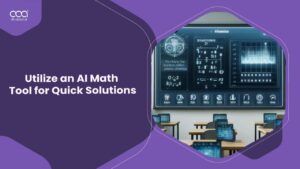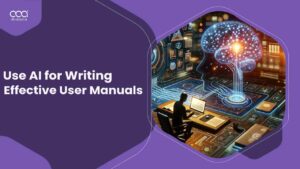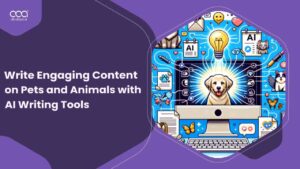In the ever-evolving digital landscape, non-profit organizations are embracing innovative technologies to enhance their operational efficiencies and communication strategies.
Best AI writing tools in France are emerging as formidable allies in this journey, offering an unmatched blend of efficiency and effectiveness in creating resonant messages. These sophisticated tools not only refine their content creation process but also ensure every piece of communication is in harmony with the organization’s core mission and values.
In this guide, we will learn “How to Use AI Writing Tools for Non-Profit Organizations in France” and why their alignment is crucial for amplifying the reach and impact of all initiatives, allowing them to connect more meaningfully with their audience.
How to Use AI Writing Tools for Non-Profit Organizations in France – Step By-Step Guide
Let’s get started by breaking down the process of integrating AI writing tools into non-profit organizations with a practical, step-by-step guide tailored to enhance your mission’s reach and efficiency.”
Step 1: Identify Key Issues and Topics
Determine the critical issues and topics that resonate with your organization’s mission and the interests of your audience.
Practical Example:
Our non-profit focuses on ocean conservation. I start by asking ChatGPT, “Identify key environmental threats to oceans in 2023.” This directed ChatGPT to provide a list of pressing issues, such as plastic pollution and overfishing, which will form the foundation of our content strategy.

Step 2: Generate Content Ideas
Use AI to brainstorm innovative content ideas that address these topics and engage your target audience.
Practical Example:
With our topics at hand, I proceed to ask ChatGPT, “Generate content ideas for social media campaigns on reducing plastic pollution in oceans.” ChatGPT suggests a series of engaging posts, including educational infographics, success stories of cleanup initiatives, and tips for individuals to reduce plastic use.

Step 3: Draft Content
Draft engaging and informative content for your chosen platforms, ensuring it aligns with your non-profit’s voice and goals.
Practical Example:
Based on the content ideas, I asked ChatGPT, “Write a draft for a blog post on the impact of plastic pollution on marine life.” ChatGPT produces a compelling initial draft that highlights the issue, discusses ongoing efforts to combat pollution, and calls for reader action.

Step 4: Personalize Communications
Personalize outreach and communication with donors, volunteers, and the community to build stronger relationships.
Practical Example:
To engage our recent donors, I instruct ChatGPT, “Create a personalized thank-you email for donors who contributed to our beach cleanup project.” ChatGPT crafts a heartfelt email that acknowledges their specific contribution, enhancing their connection to our cause.

Step 5: Create Reports and Proposals
Utilize AI to assist in creating detailed reports on your projects’ impacts and proposals for future initiatives.
Practical Example:
Needing to report on our cleanup project, I asked ChatGPT, “Summarize the outcomes of the beach cleanup project for our annual report.” ChatGPT compiles a comprehensive report detailing the amount of waste collected, volunteer engagement, and the project’s impact on local communities.

Step 6: Update and Refine Strategy
Continuously refine your content and outreach strategy based on feedback and the evolving landscape of your cause.
Practical Example:
To ensure our efforts remain impactful, I instructed ChatGPT, “Analyze the latest trends in ocean conservation efforts.” This allows us to adjust our projects and content strategy to stay at the forefront of conservation efforts, ensuring we address the most current issues effectively.

Step 7: Enhance SEO and Online Visibility
Improve your organization’s online visibility by optimizing content for search engines. This involves using AI tools to identify keywords and phrases that increase the likelihood of your content being discovered by a wider audience.
Practical Example:
To boost our blog’s reach, I asked ChatGPT, “What are the most effective SEO keywords for articles on ocean conservation?” Based on ChatGPT’s suggestions, I update our blog posts to include these keywords, improving our search engine rankings and drawing more attention to our cause.

Step 8: Monitor and Analyze Engagement
Use AI tools to track the performance of your content across platforms. Analyzing engagement helps you understand what resonates with your audience, allowing you to tailor future content for greater impact.
Practical Example:
Seeking to gauge the effectiveness of our social media campaigns, I consulted ChatGPT, “Analyze the engagement metrics of our latest Twitter campaign on reducing plastic use.” ChatGPT helps simulate an analysis, highlighting which posts performed best and why, informing our strategy for future campaigns.

Step 9: Automate Routine Communications
Streamline communication processes by automating routine messages, such as event reminders, donation acknowledgments, and volunteer opportunities. This frees up time for more strategic tasks and ensures consistent communication with your community.
Practical Example:
To efficiently manage volunteer outreach, I asked ChatGPT, “Create a template for monthly volunteer event reminders.” ChatGPT provides a customizable reminder template that we automate through our email system, ensuring volunteers receive timely and consistent notifications about upcoming opportunities.

The Advantages of Using AI Tools
Now that you understand “How to Use AI Writing Tools for Non-Profit Organizations in France” let’s some advantages of utilizing AI tools in this domain.
Utilizing AI writing tools in non-profit organizations can significantly revolutionize the way they communicate with their audience.
Efficiency:
AI writing tools revolutionize time management by automating routine writing tasks. This shift allows organizations to pivot their focus from the mechanics of writing to the strategizing of their core missions. By streamlining content creation, non-profits can allocate their resources and time towards impactful strategy development and implementation.
Consistency:
Maintaining a unified voice across various communication platforms is challenging yet crucial for brand recognition and trust. AI tools ensure consistency in messaging, reinforcing the organization’s brand and underlying values in every piece of communication. This uniformity helps in building a strong, trustworthy brand identity that audiences can easily recognize and connect with.
Personalization:
In the age of information overload, personalized communication stands out. AI enables organizations to tailor their messages to specific audience segments, enhancing the relevance and impact of their communications. This personalization fosters a deeper connection with donors and volunteers, making them feel valued and understood on an individual level.
Accessibility:
Making information accessible to diverse audiences is a cornerstone of inclusive communication. AI tools assist in breaking down barriers by enhancing content accessibility, ensuring that people from different backgrounds and abilities can access and understand the information. This inclusivity expands the organization’s reach and reinforces its commitment to serving all community members.
Innovation:
Staying ahead in the digital age requires constant innovation. AI writing tools empower non-profits to adopt cutting-edge content strategies, leveraging the latest technological advancements to engage audiences in novel and compelling ways. This continuous innovation not only captures the audience’s attention but also sets the organization apart from others.
In addition to utilizing AI tools for enhancing the operations of non-profit organizations, it’s worth exploring how AI can streamline other tasks, such as creating presentations. AI-generated slides can save valuable time and boost productivity by automating the design and content generation process, ensuring that presentations are both visually appealing and content-rich.
What Are AI Writing Tools and How Can They Transform Non-Profit Organizations?
AI writing tools harness the power of natural language processing and machine learning to produce, edit, and optimize written content with minimal human intervention. Their impact on non-profit organizations can be profound:
Content Generation:
The core capability of AI writing tools to rapidly produce high-quality, relevant content is transformative. This content efficiency supports the organization’s goals by ensuring a consistent flow of engaging content that keeps the audience informed and engaged, furthering the cause.
Audience Engagement:
By crafting personalized communication strategies, AI tools enhance the depth of connections with supporters and stakeholders. Engaged audiences are more likely to participate actively, share content within their networks, and contribute to fundraising efforts, thereby expanding the organization’s impact.
Cost Reduction:
Automating content creation significantly reduces the operational costs associated with manual content production. For budget-conscious non-profits, these savings are invaluable, allowing for a reallocation of funds towards mission-critical activities and initiatives.
Scalability:
As organizations grow, their content needs become more complex. AI writing tools effortlessly scale content production to meet these expanding requirements without necessitating a proportional increase in staff or resources. This scalability ensures that organizations can broaden their impact without incurring steep operational costs.
Innovation in Communication:
AI tools not only streamline content creation but also inspire innovative communication strategies. Whether through AI-generated insights for crafting more effective fundraising campaigns or deploying chatbots for instant supporter engagement, these tools open new avenues for creative and impactful audience interaction.
How to Use AI Writing Tools for Non-Profit Organizations in France? – Leading AI Writing Tools
In the digital transformation era, non-profit organizations are increasingly leveraging AI writing tools to enhance their communication, operational efficiency, and donor engagement. Among the myriad of options available, three tools notably stand out for their unique capabilities and transformative potential for non-profit operations: ChatGPT, Grammarly, and Google Analytics AI.
ChatGPT
ChatGPT has emerged as a pivotal tool in revolutionizing content creation for non-profits, offering a blend of versatility and advanced capabilities.

Pros:
- This feature allows non-profits to ensure that every piece of content, from social media posts to donor emails, aligns closely with their unique voice and style, fostering a consistent brand identity.
- With ChatGPT, organizations can engage their audiences through dynamic and interactive formats, making communications more engaging and effective.
- The ability to break language barriers and communicate in multiple languages widens the reach of non-profits, allowing them to connect with a global audience.
- Seamless integration with existing software ecosystems simplifies content workflows, enhancing operational efficiency.
- For budget-conscious non-profits, ChatGPT offers an economical solution for generating a wide range of content without compromising quality.
Cons:
- The vast array of features, while beneficial, can be overwhelming for new users, necessitating a learning curve.
- There’s a risk of becoming overly reliant on AI for content creation, which might stifle creativity.
- The handling of sensitive information raises concerns about data privacy and security.
- ChatGPT may occasionally struggle with understanding complex or nuanced topics, which could impact content relevance.
- Regular updates and monitoring are required to ensure the tool performs optimally, which could be resource-intensive.
Grammarly
Essential for non-profits, Grammarly ensures written content is clear, impactful, and professional, enhancing readability and audience engagement.

Pros:
- By enhancing grammatical accuracy and readability, Grammarly ensures that communications are professional and polished, crucial for maintaining credibility.
- This feature aids in adjusting the tone to suit the intended audience, crucial for effective messaging.
- Grammarly’s plagiarism checking ensures content integrity and originality, upholding ethical standards.
- Immediate feedback on potential improvements streamlines the editing process, enhancing efficiency.
- Making content more understandable broadens the reach, ensuring information is accessible to a wider audience.
Cons:
- The cost for premium features may be prohibitive for some non-profits, requiring budget considerations.
- Sometimes, the tool might suggest corrections that aren’t necessary, requiring users to discern which changes to accept.
- There may be instances where Grammarly does not fully grasp the context, potentially leading to inappropriate suggestions.
- A stable internet connection is needed for full functionality, which could be a limitation in low-connectivity areas.
- Processing sensitive content through an external tool raises data privacy concerns.
Google Analytics AI
By converting data into strategic insights, Google Analytics AI empowers non-profits with informed decision-making, optimizing performance and outreach strategies.

Pros:
- Deep insights into audience behaviors and preferences enable the development of targeted strategies.
- Recommendations for content improvements aid in enhancing engagement.
- Identifying trends in content and audience behaviors informs strategic content planning.
- Comprehensive tracking capabilities allow organizations to measure the effectiveness of their strategies.
- Future trend forecasts empower non-profits with strategic planning tools.
Cons:
- The platform’s complexity may pose a challenge to new users, requiring time to master.
- The sheer volume of data available can be overwhelming, necessitating skilled interpretation.
- Full integration with other tools may require additional technical expertise.
- Managing sensitive data requires robust security measures to protect donor information.
- To fully leverage the tool’s capabilities, a significant investment in learning and adaptation is required.
Best Practices for Integrating AI Writing Tools in Non-Profit Organizations
Integrating AI writing tools into non-profit operations necessitates a strategic approach to maximize benefits effectively.
Assessment:
Conducting a comprehensive evaluation of both organizational needs and the capabilities of AI tools is crucial for identifying the best fit. This alignment ensures that the selected tools complement the organization’s objectives and enhance its operational workflows.
Transparency:
Maintaining transparency about the use of AI tools with all stakeholders, including donors, volunteers, and beneficiaries, is essential. This openness fosters trust and helps demystify the technology’s role in the organization’s operations, encouraging broader acceptance and support.
Diverse Team:
Building a team with a diverse set of skills and perspectives is vital for the effective implementation of AI tools. Including technical experts, content creators, and strategy specialists in this team ensures a comprehensive approach to integrating AI technologies, addressing both technical and creative aspects.
Training:
Investing in thorough training programs for staff is crucial for empowering them to utilize AI writing tools to their full potential. Proper training enhances productivity and creativity, enabling employees to leverage these technologies efficiently.
Continuous Learning:
Given the rapid evolution of AI technology, staying informed about the latest advancements, updates, and best practices is imperative. Continuous learning ensures that the organization remains at the forefront of innovation, ready to adapt to new developments and opportunities in AI technology.
Resources for Non-Profits Implementing AI Technology
For non-profit organizations venturing into AI, a plethora of resources are available to guide and support their journey. Understanding and leveraging these can be pivotal in successfully integrating AI technologies.
Online Tutorials and Courses:
The digital landscape offers comprehensive guides and tutorials designed to help non-profits master AI tools. These resources range from beginner to advanced levels, ensuring organizations can build their AI capabilities progressively.

Community Forums:
Online forums serve as valuable platforms where non-profits can share experiences, challenges, and best practices related to AI implementation. These communities foster collaboration and knowledge exchange, aiding in the resolution of common technical hurdles.
Developer Support:
Many AI tool providers offer direct support from developers, ensuring non-profits can navigate technical challenges with expert assistance. This support is crucial for troubleshooting and optimizing AI applications.
Grants and Funding:
Various grants and funding opportunities are available to support non-profits in adopting new technologies. These financial resources can alleviate the cost burden, making AI tools more accessible.
Partnership Programs:
Collaboration with tech providers through partnership programs can offer non-profits tailored support, training, and access to cutting-edge AI tools. These partnerships often come with benefits such as reduced pricing or specialized support services.
How Do AI Tools Streamline Non-Profit Operations and Fundraising?
AI tools can significantly enhance the efficiency and effectiveness of non-profit operations and fundraising activities.
Automated Donor Communications:
AI enables the personalization of outreach on a large scale, ensuring donors receive messages that resonate with their interests and history with the organization.
Enhanced Data Analysis:
By analyzing donor behavior and preferences, AI tools provide insights that can inform more targeted and effective fundraising strategies.
Efficient Content Management:
AI-driven content creation and management tools streamline the production and distribution of marketing materials, saving time and resources.

Targeted Fundraising Campaigns:
Leveraging artificial intelligence for data analysis allows for the development of highly targeted fundraising campaigns, increasing the likelihood of donor engagement and contributions.
Improved Donor Experience:
AI can automate and personalize donor interactions, providing a seamless and engaging experience that fosters loyalty and support.
How to Use AI Writing Tools for Non-Profit Organizations in France – Case Studies
Explore our collection of insightful case studies showcasing how non-profit organizations are harnessing the power of AI writing tools to revolutionize their operations, enhance communication, and maximize impact on their mission-critical goals.
Non-Profits in Healthcare and Grant Writing:
Organizations such as the Bill & Melinda Gates Foundation or Doctors Without Borders often lead in adopting technology to enhance their operations. They might use AI for grant writing or to analyze health data, although specific use of AI writing tools for grants would need to be confirmed by the latest reports or their websites.
Environmental Organizations:
Groups like World Wildlife Fund (WWF) or Greenpeace are known for innovative approaches to advocacy and engagement. They could employ AI to create content for campaigns or to analyze environmental data, but direct references to AI writing tools would require checking their latest projects or technology updates.
Educational Non-Profits:
Entities such as Khan Academy or Teach For All focus on educational initiatives and could utilize AI to customize learning materials or communicate with stakeholders. The exact use of AI writing tools would be detailed in their press releases or technology blogs.
Addressing Challenges and Ethical Considerations in Implementing AI in Non-Profits
While the advent of AI technologies offers transformative opportunities for non-profits, navigating the associated challenges and ethical considerations are paramount to ensure these innovations serve the greater good without unintended consequences.
Challenges:
Some of the challenges faced by nonprofit organizations while using AI tools include;
Integration Complexity:
The process of integrating AI tools into existing non-profit systems and workflows can present significant challenges. Simplifying this integration is essential for smooth adoption, requiring both technical expertise and strategic planning to ensure compatibility and efficiency.

Data Privacy:
In the era of digital information, safeguarding the confidentiality and security of donor information is more crucial than ever. Non-profits must implement robust data governance practices to protect sensitive information, adhering to legal standards and ethical norms.
Skill Gaps:
The effective implementation of AI technologies necessitates a certain level of technical know-how, which may not be present among all non-profit staff. Bridging this knowledge gap through targeted training and education is essential for leveraging AI tools to their full potential.
Resource Allocation:
Deciding how to allocate limited organizational resources between AI technology investment and other needs is a challenging balancing act. Strategic resource allocation is key to maximizing impact without compromising on essential services.
Dependence Risk:
There’s a risk of becoming overly reliant on AI tools, which could potentially lead to operational vulnerabilities. Non-profits must ensure they maintain a balance, using AI as a complement to human judgment and expertise.
Ethical Considerations:
Here are a few ethical dilemmas non-profit organizations should consider while using AI writing tools in their work.
Bias and Fairness:
AI systems are not immune to biases, which can manifest in their outputs. Implementing measures to identify and mitigate these biases is critical for ensuring the ethical use of AI, fostering fairness and inclusivity in all AI-driven endeavors.
Transparency:
Openness about how AI technologies are used within non-profit operations is crucial for building and maintaining trust with stakeholders. Transparency in AI use helps demystify the technology and clarifies its role and limitations.
Accountability:
With the adoption of AI comes the responsibility to use these technologies ethically and responsibly. Non-profits must establish clear guidelines and accountability mechanisms to govern AI use, ensuring it aligns with their mission and ethical standards.
Data Governance:
Ethical data management practices are foundational for protecting privacy and ensuring the security of donor information. Non-profits need to adhere to stringent data governance policies to prevent misuse and uphold donor trust.
Stakeholder Involvement:
Engaging a broad range of stakeholders in discussions about AI implementation can enrich the decision-making process. This inclusive approach ensures diverse perspectives are considered, fostering ethical considerations and community-centric solutions.
Future of AI Writing Tools in Non-Profits: Trends and Predictions
The landscape of AI writing tools is on the cusp of significant evolution, heralding new possibilities for non-profit organizations.
Emerging Trends:
Increased Customization:
The drive towards more customizable AI tools is set to meet specific non-profit needs more effectively, enhancing both utility and impact.

Improved Accessibility:
Making AI technologies accessible to organizations of all sizes and budgets is a growing focus, ensuring that the benefits of AI are not limited to well-resourced entities.
Integration with Other Technologies:
The trend towards integrating AI tools with other digital technologies is expanding their capabilities and applications, offering holistic solutions to complex challenges.
Focus on Ethics:
As AI becomes more prevalent, prioritizing ethical considerations in its development and application is crucial. This focus ensures AI tools are developed and used in ways that align with societal values and non-profit missions.
Community-Centric AI:
The development of AI with direct input and feedback from the communities it serves promises more relevant and impactful technological solutions, aligning AI innovations with real-world needs.
Future Developments:
Advanced Natural Language Generation:
The advent of more sophisticated natural language generation technologies will enable the creation of content that is not only nuanced and context-aware but also deeply personalized.
Predictive Analytics Enhancements:
Enhanced predictive analytics capabilities will offer deeper insights into donor behaviors and preferences, refining fundraising strategies and operational decision-making.
AI-Assisted Strategic Planning:
AI-driven insights will increasingly inform long-term strategic planning for non-profits, providing data-driven guidance to navigate future challenges and opportunities.
Enhanced Interactivity:
The push towards more interactive and engaging content, facilitated by AI, will enrich the donor experience, fostering deeper connections and sustained engagement.
Global Reach:
Advancements in AI-driven translation and localization services will enable non-profits to break down language barriers, expanding their impact on a global scale and connecting with international audiences more effectively.
FAQs
Here are some of the most commonly asked questions about “How to Use AI Writing Tools for Non-Profit Organizations in France”
How to Use AI in a Nonprofit organization in France?
How Are Nonprofit Organizations Using ChatGPT?
How to Use AI for Nonprofit Fundraising?
Conclusion
The integration of AI into nonprofit operations offers a pathway to increased efficiency, engagement, and impact. Tools like ChatGPT and Google Analytics AI not only streamline processes but also open new avenues for interaction and fundraising. As nonprofits navigate the digital landscape, embracing AI can significantly enhance their ability to serve their missions and communities effectively.
In this article, we have thoroughly discussed “How to Use AI Writing Tools for Non-Profit Organizations in France” along with all the necessary information related to it. If want to know more about how to leverage AI writing tools in different, tools, domains, and personas, check out more articles in our “How-To Guides.”
You can also enhance your AI terminologies and concepts understanding by checking out articles in our AI Lexicon.





